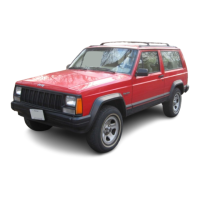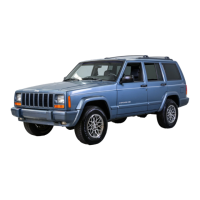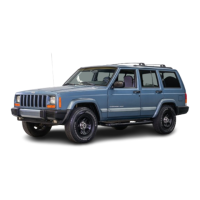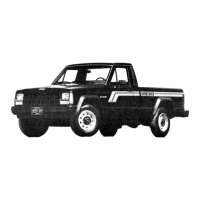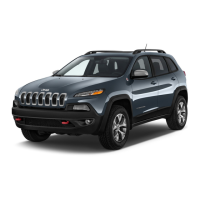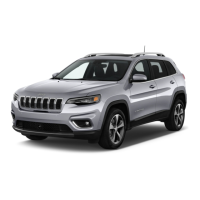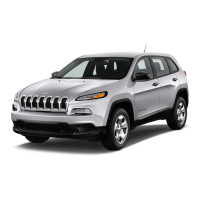Do you have a question about the Jeep Cherokee 1996 and is the answer not in the manual?
Welcome and overview of the Jeep Cherokee's capabilities and manual usage.
Guidance on navigating and utilizing the owner's manual for information retrieval.
Essential safety warnings and cautions to be observed while operating the vehicle.
Location and importance of the Vehicle Identification Number (VIN) for identification.
Information regarding the vehicle's keys, their design, and usage.
Explanation of the ignition and steering lock system for anti-theft protection.
How the vehicle signals if the key is left in the ignition to prevent accidental locking.
Details on using the single key for various vehicle access points like doors, liftgate, and glove box.
Instructions on how to lock and unlock vehicle doors using the interior rocker switch.
How to engage and disengage child protection locks on the rear doors for safety.
Operation of the power door lock system, including the driver's panel controls.
Information on the vehicle's restraint system, including seat belts and their proper use.
Explanation of the warning light and chime system to remind occupants to buckle up.
Details on the combination lap/shoulder belts (unibelts) and their retraction mechanism.
How to operate the keyless entry system for locking and unlocking doors remotely.
Information on various window types, including pop-out quarter vents.
Operation of the power windows and the driver's control panel for all windows.
Safety precautions and general information about adjusting vehicle seats.
How to adjust the front seats forward/rearward using the adjuster bar.
Instructions on adjusting the seatback angle using the seatback release lever.
How to fold the seatback forward for access or cargo space in 2-door models.
How to adjust headrests for optimal driver and passenger protection.
Operation of the six-way power seat controls for adjustment of seat position and tilt.
How to fold down the rear seat to expand cargo area and carry passengers.
Steps for removing the rear seat cushion to increase cargo space.
Information on interior and exterior mirror adjustments and features.
How to adjust the inside rearview mirror and reduce headlight glare using the night position.
Tips for adjusting outside mirrors for maximum benefit and safe driving.
Operation of the power controls for adjusting the outside rearview mirrors.
How to use the lighted vanity mirror and adjust its light intensity.
Overview of the vehicle's lighting system controls.
How to operate the main light switch for parking lights, headlights, and instrument cluster dimming.
How to switch between low-beam and high-beam headlights.
How to use the passing light feature for signaling.
How the Sentinel feature keeps headlights on for a period after engine shut-off.
Explanation of the alarm that sounds if lights are left on with the engine off.
Information about the automatic daytime running lights for Canadian models.
How to operate fog lamps and their usage conditions, with a warning about glare.
How to operate the optional front interior reading lights.
How to control the optional cargo area light and courtesy lights.
Overview of the multifunction control lever for various vehicle functions.
How to operate the turn signals for lane changes and turns.
How to operate the windshield wipers and washers, with a warning about icing.
Explanation of the intermittent wiper system's operation and delay settings.
How to adjust the steering column for entry, exit, and driving comfort, with a safety warning.
Information on rear window features like wipers and defoggers.
How to operate the rear window wiper and washer system.
How to operate the rear window defogger, with cautions about washing the window.
How to engage, set, and use the electronic speed control system for maintaining speed.
Step-by-step instructions for activating the electronic speed control system.
How to set a specific speed using the speed control system.
Methods for deactivating the speed control system, such as using the brake pedal.
How to resume a previously set speed using the RESUME/ACCEL button.
How to increase or decrease the set speed using the RESUME/ACCEL button.
How to use the accelerator for passing while speed control is engaged.
Tips for driving on hills with speed control engaged, including disengagement procedures.
Components housed in the overhead console, including reading lights and compass.
Information on the vehicle's compass and its calibration process.
Location and installation instructions for the removable cup holder.
Information about the glove box light and its battery drain potential.
How the cigarette lighter operates and its function as a safety precaution.
Step-by-step instructions for opening and closing the vehicle's hood.
Safety warning about ensuring the hood is fully latched before driving to prevent vision obstruction.
Guidelines for adjusting roof rack crossbars and distributing cargo weight evenly.
Cautions to follow to avoid damage to the roof rack and vehicle when loading cargo.
Safety warnings related to using the roof rack, emphasizing secure cargo and avoiding overloading.
How to use cargo tie-down hooks to safely secure loads when the vehicle is moving.
Warning that cargo tie-down hooks are not safe anchors for child seat tether straps.
Guidelines for loading cargo to avoid loss of control and ensure safety, especially regarding weight distribution and visibility.
Explanation of the ignition switch positions (OFF, ACC, ON, START) and their functions.
Step-by-step guide for starting the engine, covering normal and flooded conditions.
Safety warning about leaving children or animals in parked vehicles in hot weather.
Information on the engine block heater for cold weather starting.
Proper procedure for setting and releasing the parking brake and checking the indicator light.
Safety warnings related to parking brake usage, leaving children unattended, and potential brake failure.
Overview of transmission types and their basic operations.
Safe shifting practices and guidelines for manual transmissions.
Driving tips for manual transmissions to ensure safety and prolong component life.
Explanation of automatic transmission operation, including interlock systems and gear selection.
How the transmission lock functions in the Park position and its safety implications.
Warning about potential vehicle movement if the transmission is not fully in Park.
How the automatic transmission operates in Drive mode for normal driving.
Guidelines for using Drive 3 for specific conditions like hills and towing.
When to use Drive 1-2 for enhanced traction and engine braking in low-speed conditions.
Explanation of the torque converter clutch feature for improved fuel economy.
Overview of the different 4WD systems and their operational modes.
Details on the Selec-Trac system's modes and capabilities.
Instructions for shifting the transfer case between different drive modes.
When to use the 2WD position for normal driving on paved roads.
Proper usage of the 4x4 Part Time position for temporary traction needs.
How to use the 4x4 Full Time position for optimal traction in various conditions.
How to engage 4 LO for enhanced pulling power off-road, with speed and shifting precautions.
Caution regarding engaging Low Range at higher speeds to prevent transfer case damage.
Explanation of the Command-Trac system's part-time 4WD capabilities.
Warning about potential vehicle control issues if the transfer case is not fully engaged.
Caution on using Command-Trac 4-wheel drive on dry roads to prevent component stress.
How the Trac-Lok rear axle enhances traction by reducing wheel spin.
General tips for safe and efficient driving.
Driving advice for on-pavement conditions, considering vehicle dynamics.
Essential tips for driving off-pavement, highlighting unique hazards and precautions.
Guidance on utilizing low range for optimal traction and control in challenging terrain.
Specific advice for driving in adverse conditions like snow, mud, and sand.
Procedures for safely climbing steep hills, including engine and transmission management.
Safety warnings for hill climbing, emphasizing avoiding sharp turns and proper braking.
How to descend hills safely using low gear and engine braking to control speed.
Recommendations for post-off-road driving inspection and maintenance.
Comprehensive guide to tire maintenance, including pressure, wear, and replacement.
Recommended tire pressures and important checks for maintaining optimal inflation.
Crucial reminder for regular tire checks to ensure safety and longevity.
Specific tire pressure recommendations for cold weather conditions.
Critical warning about the dangers of incorrect tire maintenance, potentially leading to accidents.
Guidelines for replacing tires, including using approved sizes and types.
Cautions regarding the impact of non-standard tire sizes on vehicle performance and safety.
How to check tire wear using treadwear indicators to know when replacement is needed.
Recommended intervals for tire rotation to ensure even wear and maximize tire life.
The importance of proper wheel alignment and balance for tire wear and vehicle handling.
Guidelines for using tire chains or traction devices, including warnings about compatibility and speed.
Explanation of the ABS system and how it assists driver control during braking, especially on slippery surfaces.
Warnings regarding tire inflation, tire mixing, and the impact on braking effectiveness.
Caution regarding potential electronic interference with the ABS system from aftermarket devices.
Note on normal operational feedback from the ABS system during severe braking.
Safety tips for brake and accelerator usage, including avoiding brake riding and proper downhill braking.
Guidance on selecting the correct fuel type and octane rating for optimal vehicle performance.
Information on fuel blends containing alcohol or oxygenates and their impact.
Strong warning against using methanol-containing gasolines due to potential engine damage.
Information on reformulated gasoline and its benefits for emissions.
Guidelines for maintaining the fuel system and avoiding performance issues.
Cautions related to engine malfunctions, catalytic converter issues, and fuel system maintenance.
Critical safety information regarding carbon monoxide poisoning and prevention methods.
How to safely open and close the fuel filler door and handle the gas cap.
Warning about potential injury from rapid removal of the gas cap due to fuel system pressure.
The fuel tank capacity of the vehicle.
Importance of using unleaded fuel and proper maintenance to prevent catalytic converter damage.
Cautions regarding catalytic converter damage from engine malfunctions or overheating.
Information on trailer towing limits, safety, and maintenance requirements.
Safety warnings and guidelines for proper trailer towing to prevent accidents and damage.
Explanation of trailer weight (GTW) and tongue weight, and their importance for safe towing.
Essential equipment and requirements for towing trailers safely.
Specific vehicle requirements based on trailer type and weight for safe towing.
Tips to prevent engine and transmission overheating while towing trailers.
Caution regarding fuel selection for heavy loads to prevent spark knock and potential engine damage.
Information and requirements for equipping and using a snow plow.
Warning about potential airbag system interference when a snow plow is attached.
Cautions for operating the vehicle with a snow plow, including speed limits and plow position.
Procedure for preparing the vehicle for recreational towing.
Steps for preparing 4x4 vehicles for towing, covering transfer case and transmission settings.
Caution about potential transfer case damage if incorrect towing methods are used.
Warning about the vehicle rolling unexpectedly if the transfer case is in Neutral and the parking brake is not applied.
General guide for handling various emergency situations with the vehicle.
How to activate and use the hazard warning flasher system in emergencies.
What to do if the vehicle's cooling system overheats, including safety precautions and procedures.
Critical safety warning about the dangers of handling hot coolant and potential burns from steam.
Step-by-step guide for changing a flat tire, including safety precautions.
Location of the jack, jack handle, and lug wrench for tire changing.
Safety warnings regarding storing tools and the risk of injury from unsecured items during sudden stops.
Cautions for using the vehicle jack safely, specifying proper placement and avoiding the underbody.
How to locate and remove the spare tire.
Warning about the limitations and risks associated with temporary-use spare tires.
Detailed procedure for changing a tire, including safety steps and tool usage.
Safety warning about the danger of changing a tire too close to moving traffic.
Step-by-step guide for safely jump-starting a vehicle with a discharged battery.
Critical warnings about the dangers of jump-starting, including battery fluid hazards and hydrogen gas risks.
Location and usage of emergency tow hooks for vehicle recovery.
Warning about maintaining a safe distance when pulling with tow hooks due to potential strap or chain breakage.
Cautions regarding the intended use of tow hooks for emergency off-road recovery only.
How to tow a disabled vehicle safely, whether it's 2WD or 4WD.
Caution about potential transfer case damage if incorrect towing methods are used.
Information on connecting commercial tow trucks and the proper use of tow hooks.
Procedure for towing a Command-Trac vehicle when the ignition key is available.
Procedure for towing a Command-Trac vehicle when the ignition key is unavailable or the vehicle is locked.
Procedure for towing a Selec-Trac vehicle when the ignition key is available.
Caution about internal damage to the transfer case if a sling restricting wheel movement is used when towing.
Procedure for towing a Selec-Trac vehicle when the ignition key is unavailable or the vehicle is locked.
Procedure for towing the vehicle when the transfer case cannot be shifted to Neutral.
Caution regarding towing the vehicle with front wheels on the ground and the importance of steering column security.
Identification of major components located in the engine compartment.
Explanation of the OBD II system, its function in monitoring emissions and engine performance.
Caution regarding prolonged driving with the Check Engine Light on, which can cause further damage.
General guidelines for performing maintenance on the vehicle.
How to check fluid levels for various vehicle systems, emphasizing cleanliness and proper procedures.
Recommendations for the safe and environmentally responsible disposal of used engine fluids.
Information on selecting the correct engine oil based on API certification and viscosity grades.
Guidance on choosing the appropriate engine oil for optimal performance and protection.
Explanation of the API certification symbol on engine oil containers.
How multi-viscosity oils work and how to select the correct grade based on temperature.
Chart showing recommended engine oil viscosity grades based on anticipated temperature ranges.
Factors affecting oil change intervals, including driving conditions and time.
Caution against overfilling the crankcase, which can cause oil aeration and pressure loss.
How to check the engine oil level using the dipstick and adding oil if necessary.
Engine oil capacity for 4-cylinder and 6-cylinder engines.
Procedure for draining engine oil after the engine has reached operating temperature.
Caution regarding the Oil Pressure Warning Light and the risks of operating the engine with low oil level or pressure.
Information on changing the engine oil filter during routine oil changes.
When to replace the engine oil filter.
How to remove and install the engine oil filter.
Information on checking and maintaining the vehicle's cooling system.
How to check the coolant level in the recovery bottle and the importance of proper levels.
Procedures for checking the cooling system in an emergency, with critical safety warnings about hot coolant.
Critical safety warning about the dangers of handling hot coolant and potential burns from steam.
Recommendation for using Ethylene Glycol based coolant for Chrysler vehicles.
How to add coolant to the recovery bottle, with cautions about overfilling and temperature.
Warning about opening the engine block drain when the system is hot to prevent burns.
Procedure for draining the engine coolant from the system.
Guidelines for the proper disposal of used engine coolant, emphasizing environmental responsibility.
Instructions for draining and refilling the coolant system.
How to access and replace the engine air cleaner filter.
Warning about the function of the air cleaner in engine backfire protection and safety precautions when removing it.
Note on the recommended replacement interval for the engine air cleaner filter.
Steps for removing spark plugs.
Recommended spark plug gap specification.
Recommendation for spark plugs based on vehicle emission control information.
Information on the hydraulic clutch system and when it needs replacement.
How to check and add fluid to the manual transmission.
Procedure for checking the manual transmission fluid level.
How to add fluid to the manual transmission until the proper level is reached.
Recommended fluid type for the manual transmission.
Procedure for draining fluid from the manual transmission.
Caution against overtightening drain and fill plugs to prevent damage and leaks.
How to check the fluid level in the automatic transmission.
Procedure for checking automatic transmission fluid level at normal operating temperature.
How to fill the manual transmission with fluid after installation or service.
Information about the maintenance log for tracking service history and warranty coverage.
A log for recording scheduled maintenance services performed on the vehicle.
Categories for recording different types of maintenance services performed.
Field for recording the original owner's name.
Location and diagram of the fuse panel beneath the instrument panel.
Guidelines for installing radio transmitting equipment, considering electronic system immunity and signal integrity.
Continued guidelines for installing radio equipment, including antenna matching and interference checks.
Information related to fuel selection and capacities.
Capacities for various vehicle fluids, including engine oil, coolant, and transmission fluid.
Information on API certified engine oils and viscosity recommendations.
Recommended fluids for engine oil, automatic transmission, and power steering.
Introduction to the different 4WD systems available on the Jeep Cherokee.
Explanation of the Selec-Trac 4WD system, its modes, and year-round usage.
Explanation of the Command-Trac 4WD system, its modes, and temporary use limitations.
General introduction to the Jeep Cherokee's features and the importance of the owner's manual.
Information about the driver's air bag system, its function, and safety precautions.
Explanation of the safety feature that requires the brake pedal to be depressed to shift out of Park.
How to operate the optional remote keyless entry system.
Explanation of the ABS system and important tips for its proper use.
Information on the overhead console compass and its calibration.
How to activate and use child protection locks on the rear doors for safety.
Instructions on how to fold down or remove rear seat components for cargo space.
Tips for operating the air conditioning system for optimal cooling and comfort.
Information about Genuine Mopar parts, fluids, and accessories for vehicle maintenance.
How to report vehicle safety defects to NHTSA and Chrysler Corporation.
Contact information for reporting safety defects to Canadian authorities.
Forms for ordering service manuals and owner's manuals.
Information regarding child seat installation and usage instructions.
Explanation of legal rights related to Chrysler's limited warranties and implied warranties.
Overview of the limited warranties applicable to the 1996 model year vehicle.
Details on what the "Basic Warranty" covers, including parts, labor, and limitations.
Information on warranty coverage for towing costs to the nearest dealer for covered part failures.
Changes to the vehicle that may void limited warranties, including non-Chrysler parts and alterations.
Exclusions from warranty coverage related to environmental factors and acts of God.
Exclusions from warranty coverage for costs related to poor maintenance or non-recommended fluids.
Exclusions from warranty coverage for damage or conditions caused by racing or vehicle modifications.
Conditions under which warranty coverage is voided due to vehicle status (total loss, salvage, etc.).
Exclusions from warranty coverage related to corrosion, non-Chrysler parts, and misuse.
Guidance on where to obtain warranty service within the U.S., Mexico, and Canada.
Information on obtaining warranty service for vehicles operated temporarily outside the U.S.
Steps and procedures for obtaining warranty service for the vehicle.
Procedure for emergency warranty repairs when an authorized dealer is unavailable.
Steps to follow when encountering issues with warranty service or dealership response.
Note on state laws regarding vehicle replacement or refunds under specific warranty circumstances.
Details on the emission control system warranty for vehicles sold and registered in California.
Explanation of owner's rights and responsibilities regarding the California emission warranty.
Coverage details for emission control components based on time and mileage limits.
Owner's responsibilities for performing required maintenance and presenting the vehicle for service.
Exclusions from the California emission warranty, such as abuse, tampering, and lack of maintenance.
Owner's rights and obligations related to the California emission warranty coverage.
Details on what is covered by the warranty, including Smog Check failures and emission-related parts.
Exclusions from the emission warranty, including misuse, tampering, and non-genuine parts.
Duration of the California emission warranty for different component groups.
Owner's responsibilities for performing required maintenance and keeping records.
Information on where warranty service can be performed.
Recommendations for using genuine or remanufactured Mopar parts for maintenance and repairs.
Welcome and overview of the Jeep Cherokee's capabilities and manual usage.
Guidance on navigating and utilizing the owner's manual for information retrieval.
Essential safety warnings and cautions to be observed while operating the vehicle.
Location and importance of the Vehicle Identification Number (VIN) for identification.
Information regarding the vehicle's keys, their design, and usage.
Explanation of the ignition and steering lock system for anti-theft protection.
How the vehicle signals if the key is left in the ignition to prevent accidental locking.
Details on using the single key for various vehicle access points like doors, liftgate, and glove box.
Instructions on how to lock and unlock vehicle doors using the interior rocker switch.
How to engage and disengage child protection locks on the rear doors for safety.
Operation of the power door lock system, including the driver's panel controls.
Information on the vehicle's restraint system, including seat belts and their proper use.
Explanation of the warning light and chime system to remind occupants to buckle up.
Details on the combination lap/shoulder belts (unibelts) and their retraction mechanism.
How to operate the keyless entry system for locking and unlocking doors remotely.
Information on various window types, including pop-out quarter vents.
Operation of the power windows and the driver's control panel for all windows.
Safety precautions and general information about adjusting vehicle seats.
How to adjust the front seats forward/rearward using the adjuster bar.
Instructions on adjusting the seatback angle using the seatback release lever.
How to fold the seatback forward for access or cargo space in 2-door models.
How to adjust headrests for optimal driver and passenger protection.
Operation of the six-way power seat controls for adjustment of seat position and tilt.
How to fold down the rear seat to expand cargo area and carry passengers.
Steps for removing the rear seat cushion to increase cargo space.
Information on interior and exterior mirror adjustments and features.
How to adjust the inside rearview mirror and reduce headlight glare using the night position.
Tips for adjusting outside mirrors for maximum benefit and safe driving.
Operation of the power controls for adjusting the outside rearview mirrors.
How to use the lighted vanity mirror and adjust its light intensity.
Overview of the vehicle's lighting system controls.
How to operate the main light switch for parking lights, headlights, and instrument cluster dimming.
How to switch between low-beam and high-beam headlights.
How to use the passing light feature for signaling.
How the Sentinel feature keeps headlights on for a period after engine shut-off.
Explanation of the alarm that sounds if lights are left on with the engine off.
Information about the automatic daytime running lights for Canadian models.
How to operate fog lamps and their usage conditions, with a warning about glare.
How to operate the optional front interior reading lights.
How to control the optional cargo area light and courtesy lights.
Overview of the multifunction control lever for various vehicle functions.
How to operate the turn signals for lane changes and turns.
How to operate the windshield wipers and washers, with a warning about icing.
Explanation of the intermittent wiper system's operation and delay settings.
How to adjust the steering column for entry, exit, and driving comfort, with a safety warning.
Information on rear window features like wipers and defoggers.
How to operate the rear window wiper and washer system.
How to operate the rear window defogger, with cautions about washing the window.
How to engage, set, and use the electronic speed control system for maintaining speed.
Step-by-step instructions for activating the electronic speed control system.
How to set a specific speed using the speed control system.
Methods for deactivating the speed control system, such as using the brake pedal.
How to resume a previously set speed using the RESUME/ACCEL button.
How to increase or decrease the set speed using the RESUME/ACCEL button.
How to use the accelerator for passing while speed control is engaged.
Tips for driving on hills with speed control engaged, including disengagement procedures.
Components housed in the overhead console, including reading lights and compass.
Information on the vehicle's compass and its calibration process.
Location and installation instructions for the removable cup holder.
Information about the glove box light and its battery drain potential.
How the cigarette lighter operates and its function as a safety precaution.
Step-by-step instructions for opening and closing the vehicle's hood.
Safety warning about ensuring the hood is fully latched before driving to prevent vision obstruction.
Guidelines for adjusting roof rack crossbars and distributing cargo weight evenly.
Cautions to follow to avoid damage to the roof rack and vehicle when loading cargo.
Safety warnings related to using the roof rack, emphasizing secure cargo and avoiding overloading.
How to use cargo tie-down hooks to safely secure loads when the vehicle is moving.
Warning that cargo tie-down hooks are not safe anchors for child seat tether straps.
Guidelines for loading cargo to avoid loss of control and ensure safety, especially regarding weight distribution and visibility.
Explanation of the ignition switch positions (OFF, ACC, ON, START) and their functions.
Step-by-step guide for starting the engine, covering normal and flooded conditions.
Safety warning about leaving children or animals in parked vehicles in hot weather.
Information on the engine block heater for cold weather starting.
Proper procedure for setting and releasing the parking brake and checking the indicator light.
Safety warnings related to parking brake usage, leaving children unattended, and potential brake failure.
Overview of transmission types and their basic operations.
Safe shifting practices and guidelines for manual transmissions.
Driving tips for manual transmissions to ensure safety and prolong component life.
Explanation of automatic transmission operation, including interlock systems and gear selection.
How the transmission lock functions in the Park position and its safety implications.
Warning about potential vehicle movement if the transmission is not fully in Park.
How the automatic transmission operates in Drive mode for normal driving.
Guidelines for using Drive 3 for specific conditions like hills and towing.
When to use Drive 1-2 for enhanced traction and engine braking in low-speed conditions.
Explanation of the torque converter clutch feature for improved fuel economy.
Overview of the different 4WD systems and their operational modes.
Details on the Selec-Trac system's modes and capabilities.
Instructions for shifting the transfer case between different drive modes.
When to use the 2WD position for normal driving on paved roads.
Proper usage of the 4x4 Part Time position for temporary traction needs.
How to use the 4x4 Full Time position for optimal traction in various conditions.
How to engage 4 LO for enhanced pulling power off-road, with speed and shifting precautions.
Caution regarding engaging Low Range at higher speeds to prevent transfer case damage.
Explanation of the Command-Trac system's part-time 4WD capabilities.
Warning about potential vehicle control issues if the transfer case is not fully engaged.
Caution on using Command-Trac 4-wheel drive on dry roads to prevent component stress.
How the Trac-Lok rear axle enhances traction by reducing wheel spin.
General tips for safe and efficient driving.
Driving advice for on-pavement conditions, considering vehicle dynamics.
Essential tips for driving off-pavement, highlighting unique hazards and precautions.
Guidance on utilizing low range for optimal traction and control in challenging terrain.
Specific advice for driving in adverse conditions like snow, mud, and sand.
Procedures for safely climbing steep hills, including engine and transmission management.
Safety warnings for hill climbing, emphasizing avoiding sharp turns and proper braking.
How to descend hills safely using low gear and engine braking to control speed.
Recommendations for post-off-road driving inspection and maintenance.
Comprehensive guide to tire maintenance, including pressure, wear, and replacement.
Recommended tire pressures and important checks for maintaining optimal inflation.
Crucial reminder for regular tire checks to ensure safety and longevity.
Specific tire pressure recommendations for cold weather conditions.
Critical warning about the dangers of incorrect tire maintenance, potentially leading to accidents.
Guidelines for replacing tires, including using approved sizes and types.
Cautions regarding the impact of non-standard tire sizes on vehicle performance and safety.
How to check tire wear using treadwear indicators to know when replacement is needed.
Recommended intervals for tire rotation to ensure even wear and maximize tire life.
The importance of proper wheel alignment and balance for tire wear and vehicle handling.
Guidelines for using tire chains or traction devices, including warnings about compatibility and speed.
Explanation of the ABS system and how it assists driver control during braking, especially on slippery surfaces.
Warnings regarding tire inflation, tire mixing, and the impact on braking effectiveness.
Caution regarding potential electronic interference with the ABS system from aftermarket devices.
Note on normal operational feedback from the ABS system during severe braking.
Safety tips for brake and accelerator usage, including avoiding brake riding and proper downhill braking.
Guidance on selecting the correct fuel type and octane rating for optimal vehicle performance.
Information on fuel blends containing alcohol or oxygenates and their impact.
Strong warning against using methanol-containing gasolines due to potential engine damage.
Information on reformulated gasoline and its benefits for emissions.
Guidelines for maintaining the fuel system and avoiding performance issues.
Cautions related to engine malfunctions, catalytic converter issues, and fuel system maintenance.
Critical safety information regarding carbon monoxide poisoning and prevention methods.
How to safely open and close the fuel filler door and handle the gas cap.
Warning about potential injury from rapid removal of the gas cap due to fuel system pressure.
The fuel tank capacity of the vehicle.
Importance of using unleaded fuel and proper maintenance to prevent catalytic converter damage.
Cautions regarding catalytic converter damage from engine malfunctions or overheating.
Information on trailer towing limits, safety, and maintenance requirements.
Safety warnings and guidelines for proper trailer towing to prevent accidents and damage.
Explanation of trailer weight (GTW) and tongue weight, and their importance for safe towing.
Essential equipment and requirements for towing trailers safely.
Specific vehicle requirements based on trailer type and weight for safe towing.
Tips to prevent engine and transmission overheating while towing trailers.
Caution regarding fuel selection for heavy loads to prevent spark knock and potential engine damage.
Information and requirements for equipping and using a snow plow.
Warning about potential airbag system interference when a snow plow is attached.
Cautions for operating the vehicle with a snow plow, including speed limits and plow position.
Procedure for preparing the vehicle for recreational towing.
Steps for preparing 4x4 vehicles for towing, covering transfer case and transmission settings.
Caution about potential transfer case damage if incorrect towing methods are used.
Warning about the vehicle rolling unexpectedly if the transfer case is in Neutral and the parking brake is not applied.
General guide for handling various emergency situations with the vehicle.
How to activate and use the hazard warning flasher system in emergencies.
What to do if the vehicle's cooling system overheats, including safety precautions and procedures.
Critical safety warning about the dangers of handling hot coolant and potential burns from steam.
Step-by-step guide for changing a flat tire, including safety precautions.
Location of the jack, jack handle, and lug wrench for tire changing.
Safety warnings regarding storing tools and the risk of injury from unsecured items during sudden stops.
Cautions for using the vehicle jack safely, specifying proper placement and avoiding the underbody.
How to locate and remove the spare tire.
Warning about the limitations and risks associated with temporary-use spare tires.
Detailed procedure for changing a tire, including safety steps and tool usage.
Safety warning about the danger of changing a tire too close to moving traffic.
Step-by-step guide for safely jump-starting a vehicle with a discharged battery.
Critical warnings about the dangers of jump-starting, including battery fluid hazards and hydrogen gas risks.
Location and usage of emergency tow hooks for vehicle recovery.
Warning about maintaining a safe distance when pulling with tow hooks due to potential strap or chain breakage.
Cautions regarding the intended use of tow hooks for emergency off-road recovery only.
How to tow a disabled vehicle safely, whether it's 2WD or 4WD.
Caution about potential transfer case damage if incorrect towing methods are used.
Information on connecting commercial tow trucks and the proper use of tow hooks.
Procedure for towing a Command-Trac vehicle when the ignition key is available.
Procedure for towing a Command-Trac vehicle when the ignition key is unavailable or the vehicle is locked.
Procedure for towing a Selec-Trac vehicle when the ignition key is available.
Caution about internal damage to the transfer case if a sling restricting wheel movement is used when towing.
Procedure for towing a Selec-Trac vehicle when the ignition key is unavailable or the vehicle is locked.
Procedure for towing the vehicle when the transfer case cannot be shifted to Neutral.
Caution regarding towing the vehicle with front wheels on the ground and the importance of steering column security.
Identification of major components located in the engine compartment.
Explanation of the OBD II system, its function in monitoring emissions and engine performance.
Caution regarding prolonged driving with the Check Engine Light on, which can cause further damage.
General guidelines for performing maintenance on the vehicle.
How to check fluid levels for various vehicle systems, emphasizing cleanliness and proper procedures.
Recommendations for the safe and environmentally responsible disposal of used engine fluids.
Information on selecting the correct engine oil based on API certification and viscosity grades.
Guidance on choosing the appropriate engine oil for optimal performance and protection.
Explanation of the API certification symbol on engine oil containers.
How multi-viscosity oils work and how to select the correct grade based on temperature.
Chart showing recommended engine oil viscosity grades based on anticipated temperature ranges.
Factors affecting oil change intervals, including driving conditions and time.
Caution against overfilling the crankcase, which can cause oil aeration and pressure loss.
How to check the engine oil level using the dipstick and adding oil if necessary.
Engine oil capacity for 4-cylinder and 6-cylinder engines.
Procedure for draining engine oil after the engine has reached operating temperature.
Caution regarding the Oil Pressure Warning Light and the risks of operating the engine with low oil level or pressure.
Information on changing the engine oil filter during routine oil changes.
When to replace the engine oil filter.
How to remove and install the engine oil filter.
Information on checking and maintaining the vehicle's cooling system.
How to check the coolant level in the recovery bottle and the importance of proper levels.
Procedures for checking the cooling system in an emergency, with critical safety warnings about hot coolant.
Critical safety warning about the dangers of handling hot coolant and potential burns from steam.
Recommendation for using Ethylene Glycol based coolant for Chrysler vehicles.
How to add coolant to the recovery bottle, with cautions about overfilling and temperature.
Warning about opening the engine block drain when the system is hot to prevent burns.
Procedure for draining the engine coolant from the system.
Guidelines for the proper disposal of used engine coolant, emphasizing environmental responsibility.
Instructions for draining and refilling the coolant system.
How to access and replace the engine air cleaner filter.
Warning about the function of the air cleaner in engine backfire protection and safety precautions when removing it.
Note on the recommended replacement interval for the engine air cleaner filter.
Steps for removing spark plugs.
Recommended spark plug gap specification.
Recommendation for spark plugs based on vehicle emission control information.
Information on the hydraulic clutch system and when it needs replacement.
How to check and add fluid to the manual transmission.
Procedure for checking the manual transmission fluid level.
How to add fluid to the manual transmission until the proper level is reached.
Recommended fluid type for the manual transmission.
Procedure for draining fluid from the manual transmission.
Caution against overtightening drain and fill plugs to prevent damage and leaks.
How to check the fluid level in the automatic transmission.
Procedure for checking automatic transmission fluid level at normal operating temperature.
How to fill the manual transmission with fluid after installation or service.
Information about the maintenance log for tracking service history and warranty coverage.
A log for recording scheduled maintenance services performed on the vehicle.
Categories for recording different types of maintenance services performed.
Field for recording the original owner's name.
Location and diagram of the fuse panel beneath the instrument panel.
Guidelines for installing radio transmitting equipment, considering electronic system immunity and signal integrity.
Continued guidelines for installing radio equipment, including antenna matching and interference checks.
Information related to fuel selection and capacities.
Capacities for various vehicle fluids, including engine oil, coolant, and transmission fluid.
Information on API certified engine oils and viscosity recommendations.
Recommended fluids for engine oil, automatic transmission, and power steering.
Introduction to the different 4WD systems available on the Jeep Cherokee.
Explanation of the Selec-Trac 4WD system, its modes, and year-round usage.
Explanation of the Command-Trac 4WD system, its modes, and temporary use limitations.
General introduction to the Jeep Cherokee's features and the importance of the owner's manual.
Information about the driver's air bag system, its function, and safety precautions.
Explanation of the safety feature that requires the brake pedal to be depressed to shift out of Park.
How to operate the optional remote keyless entry system.
Explanation of the ABS system and important tips for its proper use.
Information on the overhead console compass and its calibration.
How to activate and use child protection locks on the rear doors for safety.
Instructions on how to fold down or remove rear seat components for cargo space.
Tips for operating the air conditioning system for optimal cooling and comfort.
Information about Genuine Mopar parts, fluids, and accessories for vehicle maintenance.
How to report vehicle safety defects to NHTSA and Chrysler Corporation.
Contact information for reporting safety defects to Canadian authorities.
Forms for ordering service manuals and owner's manuals.
Information regarding child seat installation and usage instructions.
Explanation of legal rights related to Chrysler's limited warranties and implied warranties.
Overview of the limited warranties applicable to the 1996 model year vehicle.
Details on what the "Basic Warranty" covers, including parts, labor, and limitations.
Information on warranty coverage for towing costs to the nearest dealer for covered part failures.
Changes to the vehicle that may void limited warranties, including non-Chrysler parts and alterations.
Exclusions from warranty coverage related to environmental factors and acts of God.
Exclusions from warranty coverage for costs related to poor maintenance or non-recommended fluids.
Exclusions from warranty coverage for damage or conditions caused by racing or vehicle modifications.
Conditions under which warranty coverage is voided due to vehicle status (total loss, salvage, etc.).
Exclusions from warranty coverage related to corrosion, non-Chrysler parts, and misuse.
Guidance on where to obtain warranty service within the U.S., Mexico, and Canada.
Information on obtaining warranty service for vehicles operated temporarily outside the U.S.
Steps and procedures for obtaining warranty service for the vehicle.
Procedure for emergency warranty repairs when an authorized dealer is unavailable.
Steps to follow when encountering issues with warranty service or dealership response.
Note on state laws regarding vehicle replacement or refunds under specific warranty circumstances.
Details on the emission control system warranty for vehicles sold and registered in California.
Explanation of owner's rights and responsibilities regarding the California emission warranty.
Coverage details for emission control components based on time and mileage limits.
Owner's responsibilities for performing required maintenance and presenting the vehicle for service.
Exclusions from the California emission warranty, such as abuse, tampering, and lack of maintenance.
Owner's rights and obligations related to the California emission warranty coverage.
Details on what is covered by the warranty, including Smog Check failures and emission-related parts.
Exclusions from the emission warranty, including misuse, tampering, and non-genuine parts.
Duration of the California emission warranty for different component groups.
Owner's responsibilities for performing required maintenance and keeping records.
Information on where warranty service can be performed.
Recommendations for using genuine or remanufactured Mopar parts for maintenance and repairs.
| Brand | Jeep |
|---|---|
| Model | Cherokee 1996 |
| Category | Automobile |
| Language | English |
